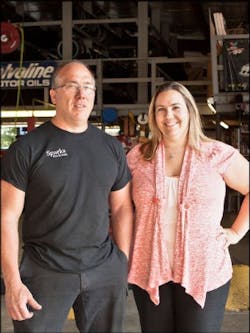Ron Tinner was taking a huge risk.
Four years of stagnant sales and rising costs put Tinner at a crossroads in early 2013. He’d worked at Sparks Tire & Auto since 1986. He bought the shop in 2000. He built it into a $1 million company by 2008.
And he watched it slowly sink as his St. Charles, Mo., market plummeted with the economic recession.
Improved operations and marketing helped the shop cling to a functional level, but Tinner was beginning to feel the toll of the “grind.” As he puts it, “I’m older, my staff is older—all of them have families—we didn’t want to be grinding out six days in the shop every week.”
Tinner had a simple plan: For the first time in his nearly 30 years at the shop, they would close on Saturdays. It was simple math; cut overhead, add in improved morale and efficiency, and maintain sales while increasing profit.
Call it addition by subtraction. Call it a risk. Tinner calls it his business-changing strategy.
“So, how do you make more money in less days?” Tinner asks rhetorically. “That was the question.”
A calculated, creative marketing strategy was the answer.
The Backstory
Sparks Tire & Auto did roughly $300,000 in total sales in its first year under Tinner’s guidance in 2000. It was a typical, local independent shop—four employees, 6,000 square feet and a solid standing in the community.
Tinner wanted put some new life into it.
He became a NAPA franchise, and became AAA certified.
“Around that time, simply doing that was enough to spell out success,” he says. “You put those types of brands behind you, and it just exponentially builds that trust.”
And that was the overall scope of Tinner’s early marketing strategies—hang a shingle (with some big names backing it), roll up his sleeves and win customers over the old-fashioned way with great service and quality work.
And it did work. Business skyrocketed, more than tripling in an eight-year span.
The Problem
Tinner hates using the recession as any sort of excuse for lackluster business. But, from an outsider’s perspective, it’s difficult to deny.
Part of the shop’s staggering success leading up to 2008 was due to large fleet accounts—37 of them that made up roughly 34–36 percent of the shop’s overall business.
Then came 2009 and the fall of the U.S. economy. It didn’t affect Tinner’s commercial consumer base, but it crippled those fleets. Businesses in St. Charles started closing, or at best, drastically downsizing. He lost 31 fleet accounts, more than 20 percent of his business.
By chance, that was the same year his daughter, Jessica Carrino (Tinner at the time), graduated college and joined the company. Carrino was looking into a career in marketing, and her dad had an idea of how she could put her education to use.
“She was going to do marketing for someone; we needed it, and why not have her do it for us?” Tinner says.
Carrino jumped right in—and was immediately taken aback by the shop’s current marketing practices.
“Basically, we didn’t have any,” she says. “My dad was doing everything in the business when I came in, and it’s just too hard to do everything he does and put real effort into marketing.”
Carrino began by marketing to current customers through direct mail. She tried different offers and tactics until the shop found a “sweet spot” with a reward program they called the “wow card.” It’s a loyalty card that gives small discounts on certain services. The program got an immediate 52 percent return.
“It’s taken a while to get things going, but we just built from there,” Carrino says.
They improved the website, started social media and began working with a pair of customer retention programs (one through NAPA, and also through Mechanic Net).
The effort slowly paid off, and the shop pulled out of the red in 2012. Still, hovering around $900,000 in annual sales, Tinner wanted his business to take another leap forward—past its banner year of 2008, and toward a future of sustained growth.
The Solution
It seems backwards to many: In order to grow, chop off one of your busiest business days of the week.
Some obvious negative repercussions: a drop in sales, the loss of “weekend” customers, a decrease in man hours to complete work.
“I’d talked to my team about it, and I felt that the loss in hours would be made up for in improved morale and efficiency,” Tinner says. “A lot of this was quality of life. I’ve been in this business for 30 years, and I’ve worked Saturdays for 28 years. A lot of the guys felt the same way.”
We hear it with clients all the time: They have great word of mouth reputation, they have great brand awareness in their communities. We say, “That’s great. Show me the numbers that support that?” Bottom line: If you’re not tracking your marketing, it is extremely difficult to be effective. The goal of marketing is to offset customer attrition, and to add to and upgrade your base to higher quality customers. In order to do that, you need to know whom to reach, where and how to reach them, and the effectiveness of each campaign. You can’t know this without tracking. You can’t pick up those high-quality customers without tracking. Start simple: Ask people why they came in, and track that. Then get more and more sophisticated. The more you understand and know about your marketing, the more effective it will be.
There was still the drop in sales and the loss of the weekenders to account for in his plan, though. That’s where Carrino’s marketing would come in.
By 2013, Carrino’s strategies were beginning to hit their stride.
She tracked every marketing dollar spent in the shop through the business’s management system (NAPA TRACS). She created labels for each campaign, and when a job came in, it would get tagged. They could then see exactly how many people a campaign brought in, and what those customers paid for. In other words, she had a clear understanding of the ROI and which items were most effective.
With the plan to cut a day of operation each week, it was time for Carrino to ramp things up.
She used email marketing to notify current customers of the schedule change, and sent postcards to those the shop didn’t have email addresses for. They explained it to customers when they were in the shop.
And they began pushing other campaigns, like the company’s long-standing “car club” that was often ignored. It allowed customers to purchase a booklet of deals (at a roughly $500 value) for $100.
Carrino also added DemandForce as another retention tool for the shop, and used that along with the NAPA and Mechanic Net programs for service reminders.
They also began doing a “Tires at Cost” campaign, where they promoted and sold tires at, you guessed it, cost. They made money on the labor, but Tinner says it was a great way to bring in new customers and win them over long-term.
Finally, Carrino began personally calling customers within a day after their vehicles left the shop—checking in on how everything was going, and thanking them for their trust.
“I know she was worried that she’d get complaints or things,” Tinner says, “but she hasn’t gotten a single one. When you get out ahead of things like that, and put yourself out there, you’re going to get a great response.”
With everything humming, Sparks Tire & Auto closed on a Saturday for the first time in company history last September.
The Aftermath
The shop’s marketing budget is roughly $30,000(about 3.3 percent of the shops annual revenue), quite low compared to industry standards. (Many consultants suggest keeping it closer to 6 percent.) But every dollar is strategically spent.
And the returns make that pretty clear. Email and direct mail are the company’s two most consistent campaigns—both yielding 12–15 percent returns on nearly every campaign. The “wow cards” still average between 40–60 percent.
“Those are so effective because they go to our current customer base,” Tinner explains. “If you can’t get between 10–15 [percent return] on your current customers, then it’s not working. That’s our requirement.”
Tinner also wants each new-customer campaign to hit 3–5 percent, more than double the industry benchmark of 1–2 percent.
Overall, the marketing has paid off. Sales were up 4 percent in 2014, despite losing one day each week in production. Overhead is down, shop efficiency is up, and, although he prefers to not disclose the number, profitability is “way up.”
The bottom line: The shop is making money, and its long-term future has never been brighter, Tinner says.
The Takeaway
Track—track everything you can in your shop; that’s the lesson, Tinner says. Whether it’s technician efficiency or ROI on a post-card mailer, if it affects your business, you better be able to put numbers to it.
“Tracking is the reason why our marketing works,” he says. “We don’t just do a bunch of [campaigns]. We find things that work, and repeat them. If you’re not doing that, you’re wasting money.”
And you’re taking unnecessary risks with your business’s future. Tinner took a chance by closing on Saturdays, but he says it was a calculated risk, not a reckless one.
“We took that leap, and I’m glad we did,” he says. “Now we just have to keep this going.”
About the Author

Bryce Evans
Bryce Evans is the vice president of content at 10 Missions Media, overseeing an award-winning team that produces FenderBender, Ratchet+Wrench and NOLN.
